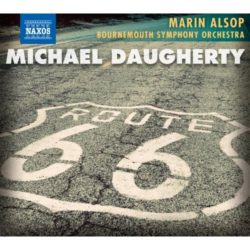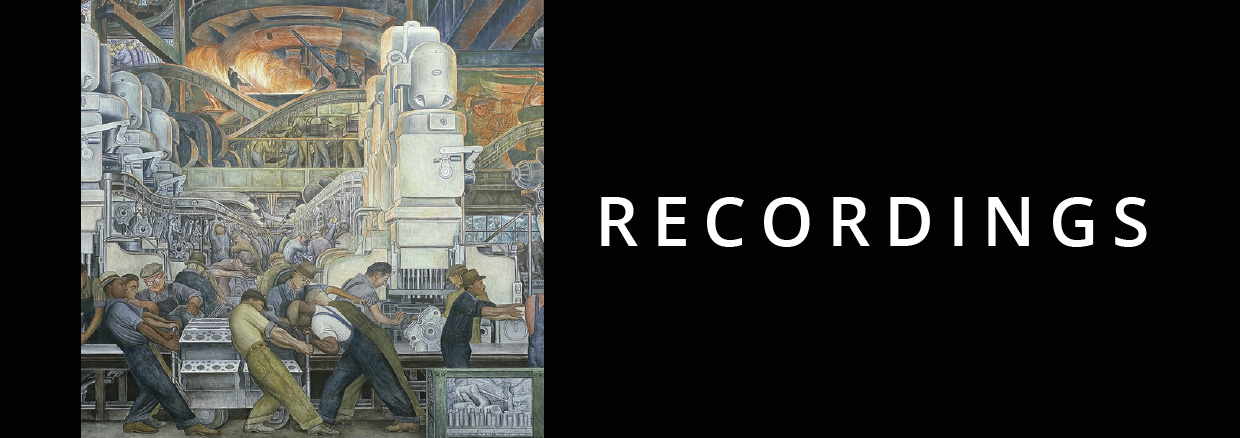Route 66
Naxos/January 2011
Route 66/Ghost Ranch/Sunset Strip/Time Machine
Bournemouth Symphony Orchestra
Marin Alsop, conductor

REVIEW FROM GRAMOPHONE, APRIL 2011:
Route 66, the famous highway that runs from Chicago to Los Angeles, acts as a rather appropriate metaphor for Michael Daugherty’s music. The experience of listening to his music is like travelling the length and breadth of America’s musical traditions: one is often swept along by the music’s eclectic currents, ranging from Gershwin, jazz and blues to Reich, Adams and rock.
It is also an apt metaphor because Daugherty is something of a musical travelogue. BothGhost Ranch and Sunset Strip deal with journeys of different kinds – the latter a vivid and self-consciously kitsch evocation of one of America’s most celebrated boulevards, the former more a portrait of rugged isolationism in New Mexico inspired by the work of artist Georgia O’Keeffe. At its best, Daugherty’s synthesis of melodic directness, rhythmic energy and mellifluous orchestration is absorbing and exhilarating, yet the music can become too narrative at times.
The composer states that his music “hovers between realism and abstraction”, and when the two elements are combined in more or less equal quantities – such as in the beautiful opening of Ghost Ranch with its gently unfolding canons – there is no doubting the music’s creative and expressive power. When the music weighs too much towards either one, the result is arguably less convincing, as in the programmatic realist literalism of the third movement of Sunset Strip or the abstract cerebral ruminations of Time Machine (for three conductors and orchestra). There is much to admire about this lively and colourful recording, however, not least the manner in which the Bournemouth Symphony Orchestra under Marin Alsop actively thrive on playing music that communicates in such an immediate and engaging way.
REVIEW FROM CLASSICALCDREVIEW.COM, MAY 2011
You win some. I consider Michael Daugherty one of the best of a very talented crop of current American composers, including Rosner, Higdon, Adams, Carter (103! at this time and still writing), Rouse, and Reich. Daugherty’s idiosyncratic sensibility, in sync with pop and trash as well as with high art, attracts me. Here’s one composer who seems able to draw on the entire American experience, from Beacon Hill to Vegas. If your heartbeat doesn’t quicken a little at the thought of Liberace or at the sight of White Castle’s gleaming tiles, much of Daugherty’s appeal might prove elusive.
Most of the work on this CD touches on the mythic American West. I find two successes and two misses. Route 66 evokes a high-speed cross-country drive, with one stop for a red light (a tuba solo). It has the energy of a hamster on crack. The piece begins with a close rhythmic canon on four trumpets, and insists on a particular rhythm (3+3+2) along most of its course. As it proceeds, we accelerate. A grand theme evokes the wide open spaces and big skies of the West. Toward the end, a cowbell knocks out, in Daugherty’s phrase, “a Latin groove” which becomes more and more prominent. We end on a contrapuntal extravaganza as all the ideas (and perhaps some new ones thrown in just for fun) sway with one another, like dancers at aferia, each one busting his or her individual move at the whim of a moment. I’d say that the piece was “fun,” but that would diminish it. It’s fun at the same level as Copland’s Rodeo or Stravinsky’s Pulcinella.
Daugherty also draws inspiration from Modern painting, notably Diego Rivera and Frida Kahlo in the violin concerto Fire and Blood. Raise the Roof paid homage to iconic buildings. In three movements—“Bone,” “Above Clouds,” and “Black Rattle”—Ghost Ranch tries to evoke the work of Georgia O’Keeffe, long resident in New Mexico. It didn’t do that for me, so I concentrated on the music itself, which I found uninteresting in itself. I should add that reviewers seem split over this work. Some see it as a “deepening” of Daugherty’s music. I certainly regard it as an attempt to branch out, and I applaud the composer for it. However, I feel he has succeeded in works like Fire and Blood and Brooklyn Bridge and just doesn’t cut the mustard here.
I can say the same of the most elaborate work on the program, Time Machine. Written in two movements (“Past” and “Future”) for three onstage orchestras (Daugherty specifies the placement) and apparently requiring three conductors, it strikes me as bland, something I wouldn’t have said about Daugherty until now. Furthermore, I don’t see why he needs three conductors. There’s nothing all that asynchronous or “phaseworthy” about the material, but for a few passages in the percussion, and surely professional symphonic percussionists have a sharp enough sense of time to manage on their own. Daugherty states that he wants to give the listener of moving back and forth through time as one would in space, so perhaps a stereo recording provides too grainy a sonic image. You just might have to hear the piece live to get what the composer intends. I preferred the “Past” to the “Future,” which lacked the drama that Daugherty has stated he intends. The past gambols (a mock Early Renaissance dance) and sings (an evocation of Romanticism). The future apparently is grayer than an Ohio winter.
Sunset Strip gets its inspiration from west Los Angeles’s legendary Sunset Boulevard, a street that goes through some posh L. A. neighborhoods like Brentwood and Beverly Hills as well as glitz (Dino’s Lodge, owned by Dean Martin, fronted the Strip) and decline (so did Whiskey a Go-Go). In three movements, it depicts an evening on the boulevard. The first movement begins with a riff very similar to the opening of Quincy Jones’s theme from “Hawaii Five-O.” Two trumpets sound mainly in duet, and we cruise through a night of steamy L. A. noir, with a light Latin beat (on cowbell) occasionally brought to the surface. The music swaggers, self-consciously cool. The contemplative and brief second movement is a big-city night piece, remarkably scored for two solo trumpets and two percussionists. It gives you the lonely after-hours feel of a jazz club, as echoes of “Fly Me to the Moon” as drafts from the air conditioning sweep scraps of paper across the floor. In the finale, Los Angeles wakes to a gentle Latin-Caribbean beat. The music quickly grows more lively and optimistic as the city rouses itself to face another day.
The Bournemouth, under Marin Alsop’s guidance, plays with the brashness of an American orchestra, which suits this music down to its native ground. Another winner in Naxos’s Daugherty mini-series.
~Steve Schwartz
